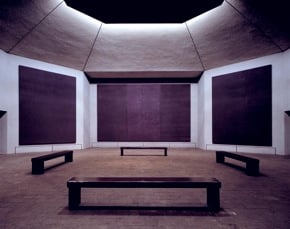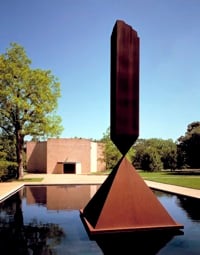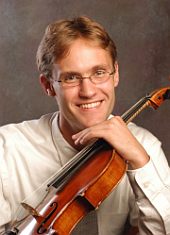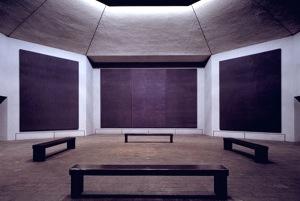In what would prove to be the last great achievement of his career, the New York abstract expressionist painter Mark Rothko undertook in 1964 the creation of 14 huge canvases for an octagonal chapel in Houston. It was a daunting project for an artist showing the strains of a life riven by alcohol, mounting health woes, and psychological torment. Unable to complete the project alone, Rothko hired assistants to help with the towering, dark-hued panels. The artist himself was destined never to see his final vision fulfilled. In 1970, a year before the chapel’s opening, he committed suicide.

Photos by Hickey Robertson
Slideshow
View all images (6)
Buy Tickets
San Francisco Symphony: MTT conducts Mozart’s Requiem
Venue: Davies Symphony HallCity: San Francisco
Date: February 23, 2011 8:00pm
Price Range: $35-$135
Related Article
Renaissance Symphony: The San Francisco Symphony's Rise to Greatness
December 8, 2010
Today, 40 years later, the Rothko Chapel retains its powerfully ambiguous hold on pilgrims from around the world. In 2005, violist Jonathan Vinocour was one of those visitors, urged by musician friends to see the place. He recalled it in a recent conversation.
“When you’re standing in the chapel, you’re surrounded by the paintings, which are very large,” said Vinocour. “Rothko wanted you to be close to them, close enough to feel they are enveloping you. On the one hand it’s peaceful, because the paintings are so still, with no dynamism. On the other hand, they are so dark you feel you’re being sucked into a void. It’s a very ominous feeling.”
Vinocour, now the principal violist of the San Francisco Symphony, couldn’t have known it at the time, but that trip to Houston was going to figure six years later in his musical life. This month, in the February 23-26 concerts at Davies Symphony Hall, Vinocour will perform the haunting viola solo part in Rothko Chapel, a 1972 composition by Morton Feldman. Michael Tilson Thomas conducts the San Francisco Symphony in a spiritually infused program that joins the half-hour Feldman piece to Mozart’s final, unfinished work, his Requiem in D Minor, K. 626. It’s a potent linking of works that capture the tenacity and transcendence of artistic endpoints.
Contemplating Musical Time
Feldman, as a friend of Rothko’s and a composer with deep and long-standing affinities with other visual artists, had a primary personal investment in this piece. It was commissioned by the same Menil Foundation that had financed the construction of the chapel and engaged Rothko to create its site-specific paintings. Fittingly, Feldman’s composition, one of his best known, received its world premiere in the space that inspired and gave the work its name.
Scored for a reduced orchestra, percussion ensemble, chorus, four vocal soloists, and viola solo, the piece forges what Vinocour, who is 31, calls “a real kinship between Feldman and Rothko,” where “time is like a flat canvas. He [Feldman] is putting elements onto that canvas that don’t necessarily stand in dramatic relationship to each other.”

Long-sustained blocks of sound, somewhat like the rectangles set afloat in Rothko’s numinous paintings, summon the listener into a spacious, contemplative state. It’s not an unfamiliar sensation, conjured in different ways by such composers as Steve Reich, Philip Glass, and Arvo Pärt. Yet Feldman’s use of timbre, orchestral shading, and pattern weaves a spell of a distinctively expansive character.
In a rapturous though keen-eared appreciation of Rothko Chapel, freelance critic and blogger Tim Johnson writes,
The workings of the music in time, and its interaction with memory, create expectations about how it might develop, how repetitions might unfold themselves. But Feldman undercuts these expectations at every turn so that the music both invites us to anticipate its future development, and also to look back to revise our impressions of what we thought earlier moments implied. Time turns to amber.
In liner notes for a New Albion recording of the piece, the composer explained that he wanted to mirror the permeating “rhythm” of the paintings with “an unbroken continuity” in the music. Both works may be abstract, but Feldman’s Chapel does not aim to match or aurally illustrate the paintings. Art and music are inherently different media, with different expressive means. “While it was possible with the paintings to reiterate color and scale and still retain dramatic interest,” wrote Feldman, “I felt that the music called for a series of highly contrasted merging sections. I envisioned an immobile procession not unlike the friezes in Greek temples.”
A Remembered Melody

The piece opens with a “declamatory” but meditative opening, followed by what Feldman calls “a more stationary ‘abstract’ section” scored for chorus and chimes. A third section features the soprano (singing a melody Feldman wrote on the day of Igor Stravinsky’s memorial service), timpani, and viola. In the striking final section, the viola spins out the most tangible melody of the piece over a vibraphone ostinato. Feldman composed that “quasi-Hebraic” tune when he was 15 years old, inserting it here as a parting personal signature.
“It’s the first time you have a standard feeling of pulse and time,” said Vinocour. “Feldman instructs you to play it very, very simply. It actually feels like a kind of relief.”
For Johnson, “There is no more stunning passage in postwar composition than this.” He continues, “To suddenly introduce such a simple, almost childish idea as this vibraphone ostinato, and use it to underpin a melody of breathtaking beauty and naivete, is extraordinary, and I don’t know of any moment like it in Feldman’s output.”
Rothko Chapel, like the Chapel and paintings themselves, survives as one of only a few works of abstract modernism to find a strong, general audience. It is far and away Feldman's best-known piece and, in a fortuitous artistic connection, it will be played by Da Camera at the Chapel itself the same week as its San Francisco Symphony performance, in honor of the Chapel's 40th year.
Vinocour, who came to the San Francisco Symphony in 2009 after two years as principal violist of the St. Louis Symphony, said the challenge of the piece is personal and interpretive rather than technical. “The actual viola part here is not so demanding. This is definitely not [Berlioz’] Harold in Italy or the Bartók Concerto.” Performing Rothko Chapel, he said, “is largely about putting yourself in the mental and emotional world of the piece.” Vinocour remarked that he’s been listening to a lot of Feldman, with another work by the composer, The Viola in My Life, as a particularly useful touchstone.
He’s also been recalling his college years at Princeton. “Rothko prints were very popular in dorm rooms. But they tended to be the ones with bright colors!”
Rothko Chapel, he believes, strikes listeners in a variety of ways, “depending on what phase of life you’re going through. For me, it’s sort of like the paintings are caressing you. There’s something comforting but also troubling at the same time.
“It’s great music,” said Vinocour, who has an active life as a chamber musician. “Feldman is one of a kind, in a world of his own in terms of American composers.” Asked if he’s thought of undertaking other Feldman projects, Vinocour laughed. “There’s one string quartet that’s approximately six hours long,” he said. “No one’s asked me to do that.”





